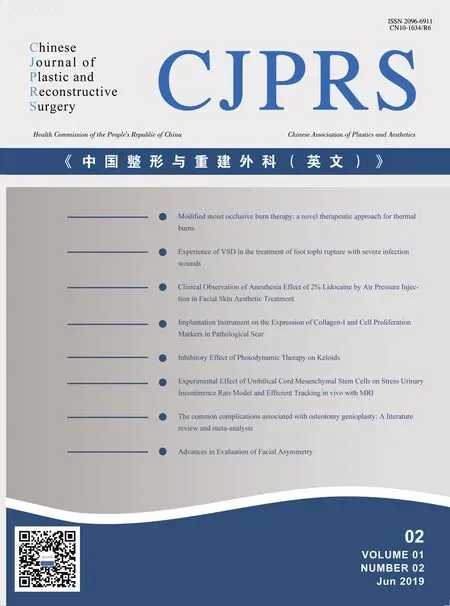Modified moist occIusive burn therapy:a noveI therapeutic approach for thermaI burns
Chao LIAN,Jun-Zhe ZHANG,Yan-Ran LI,Hai-Li LIU,Xiao-Jun LIU,Xue-Lei LI*.
1Department of Plastic and Reconstructive Surgery,Changzhi People’s Hospital,Shanxi Medical University,Changzhi,Shanxi,P.R.China.
2Department of Orthopedic Surgery,the Third Hospital of Hebei Medical University,Shijiazhuang,Hebei,P.R.China.
3Department of Neurology,Xuanwu Hospital,Capital Medical University,Beijing,P.R.China.
4Department of Plastic and Reconstructive Surgery,Nanfang Hospital,Southern Medical University,Guangzhou,Guangdong,P.R.China.
ABSTRACT Severe thermal burns usually result in complex facial problems such as contracture and formation of hyper/hypopigmentation,contracture,hypertrophic scars or deformity,with patients often requiring reconstructive surgery.Therefore,seeking a superior and reliable burn therapy remains a great challenge for plastic and burn surgeons.However,the optimal treatment of thermal injuries remains controversial.In the 1960s,a new therapeutic concept,that sterile polyethylene film might be used as a type of moist occlusive dressing,was successively proposed.Below we present a hypothesis that combined utilization of sterile polyethylene film and burn cream may be a novel and superior therapeutic approach for thermal burns.To distinguish this method from traditional moist burn therapy,this new therapy we proposed is named modified moist occlusive burn therapy (MMOBT).
KEY WORDS thermal burns;modified moist occlusive burn therapy;
INTRODUCTION
Thermal burns are explained by heat damage,a chemical process that induces the production of alkaline substances and results in destructive effects on the skin[1].The depth of a thermal injury depends on the temperature,skin thickness and duration of contact[2].Burn injuries can be classified as minor,moderate or major according to criteria such as depth,extent of injury and age.For firstand second-degree burns,healing is the primary intention and is almost scarless.However,in deep second-degree and third-degree burns,the healing process usually leads to contracture and formation of hypertrophic scars,with patients often requiring reconstructive surgery[3-4].Generally,appropriate debridement and covering with burn cream is the primary choice for emergency management of such thermal burns[5-8].
Traditionally,two types of therapy,moist occlusive burn therapy (MOBT)and moist exposure burn therapy (MEBT)are commonly used in burn units[9-11].However,the optimal treatment remains controversial.Several studies were designed to compare the effectiveness of occlusive and exposure dressing.In 2012,Mabrouk found that moist occlusive dressing significantly improved the healing rate of partial thickness facial burns with better long-term outcomes than moist exposure dressing.Scar quality was improved in the occlusive group.The frequency of dressing changes,pain and patient discomfort were also reduced in the occlusive group[12].Nevertheless,in 2016,Sharifi-Yazdi found that occlusive dressing was more susceptible to microbial contamination and infections than exposure dressing.Although heavy colonization by skin and wound flora is often observed under certain types of occlusion,clinical infection is not a frequent occurrence[13].Due to the limitations of both treatments,a novel superior therapeutic approach for thermal burns is urgently needed.
In 1962,Winter studied the effects of keeping the wound surface moist on the skin of young domestic pigs.He found that when the wounds were kept moist and covered with a relatively inert and impermeable film,epithelization of the denuded surfaced occurred approximately twice as rapidly as it occurred on wounds exposed to air[14].Coincidentally,Hinman reported parallel studies performed on healthy adult male volunteers in 1963.The experimental wound was occluded with sterile polyethylene film,while the control wound was left exposed to the air.This study also indicated that re-epithelization occurred more rapidly in the occluded wound than in the air-exposed control[15].Based on the studies by Winter and Hinman in the 1960s,a new therapeutic concept,that sterile polyethylene film might be used as a type of moist occlusive dressing,was successively proposed.Therefore,we hypothesize that combined utilization of sterile polyethylene film and burn cream may create a successful paradigm for the evolution of traditional burn treatment in clinical trials.To distinguish this method from traditional MOBT,the method that we proposed was called modified moist occlusive burn therapy (MMOBT).
HYPOTHESES
Our hypothesis is that MMOBT may be a novel and superior therapeutic approach for thermal burns.
TESTING THE HYPOTHESES
We are currently conducting a series of case studies to investigate the effectiveness of applying MMOBT in patients with different kinds of thermal burns including molten metal burns[16-17].Fig.1 shows an example of a typical scald burns case.A 1-year-old baby girl with an accident cervicofacial scald due to splashing boiled water was admitted to our department for second-degree burns affecting 4% of his total body surface area,including his face and anterior neck.A physical examination revealed ulcerations and blisters covered by yellow exudates,swelling and intense pain affecting injured area (Fig.1A).Following appropriate debridement,MMOBT was carefully performed.The wounds were successively covered by modified chitin wound rehabilitating biogel (AmPoSa (®))and sterile polyethylene film,which was changed every 2 days (Fig.1B).Systemic antibiotics (third generation cephalosporin)were prescribed,and the patient was closely monitored.After a 54-day admission,the patient was totally healed and discharged home.After 1-year follow-up,the baby girl had achieved a favorable aesthetic restoration without significant complications (Fig.1C).
DISCUSSIONS
Although MOBT and MEBT had been widely used in burn units,the optimal treatment of thermal burns remains controversial.It is worth noting that MMOBT not only combines the advantages of both MOBT and MEBT,but also eliminates the major disadvantages of both methods.First,compared to MOBT,sterile polyethylene film effectively avoided the avulsion of new granulation tissue and alleviated the suffering of patients during dressing changes.Second,the transparent film allowed direct and close observation of the changes and healing of wounds.Third,compared to MEBT,the sterile polyethylene film covering could create a relatively closed and moist environment that could accelerate the speed of epithelization.To our knowledge,a study describing MMOBT has not been reported previously.Preliminary research has shown that MMOBT has a beneficial effect on cervicofacial thermal burns.Its future utilization is proposed as an alternative treatment for thermal burns.Further related studies are required to confirm the effectiveness and superiority of this new therapeutic modality.
SOURCES OF SUPPORT IN THE FORM OF GRANTS
None.
CONFLICTS OF INTEREST STATEMENT
None.
 Chinese Journal of Plastic and Reconstructive Surgery2019年2期
Chinese Journal of Plastic and Reconstructive Surgery2019年2期
- Chinese Journal of Plastic and Reconstructive Surgery的其它文章
- Instructions for Authors
